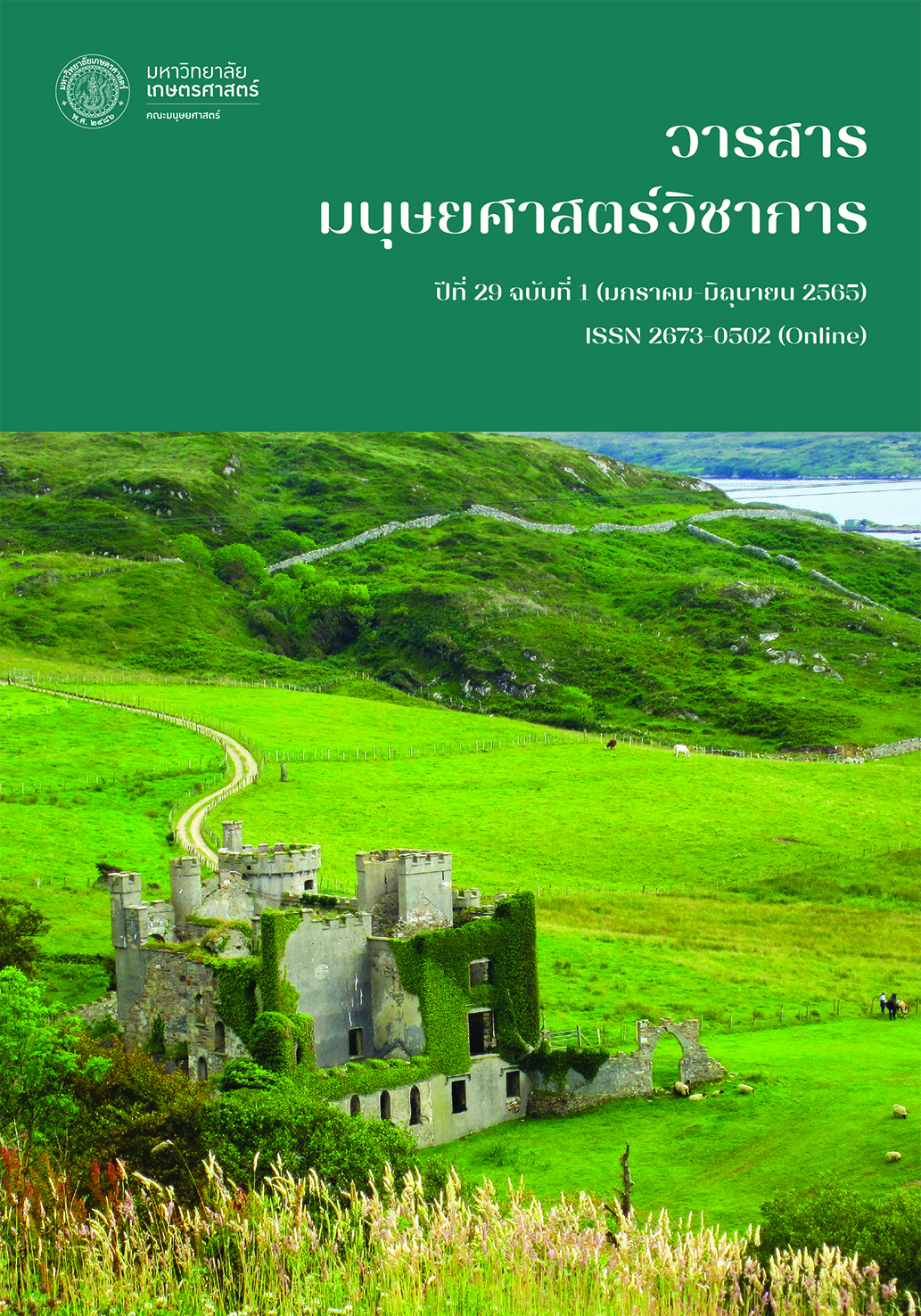อุดมการณ์เกี่ยวกับ “คนพม่า” ในความเรียงของนักเรียนพื้นที่ชายแดนไทย-เมียนมา การศึกษาตามแนววาทกรรมวิเคราะห์เชิงวิพากษ์
Main Article Content
บทคัดย่อ
งานวิจัยนี้มีวัตถุประสงค์เพื่อศึกษาการสื่ออุดมการณ์เกี่ยวกับ “คนพม่า” ผ่านกลวิธีทางภาษาต่างๆ ในงานเขียนของนักเรียนที่อาศัยอยู่ในพื้นที่ชายแดนไทย-เมียนมา อำเภอแม่สาย จังหวัดเชียงราย ตามแนววาทกรรมวิเคราะห์เชิงวิพากษ์ (Critical Discourse Analysis) งานวิจัยนี้ศึกษาจากข้อมูลความเรียงของนักเรียนชั้นมัธยมศึกษาตอนปลายในเขตอำเภอแม่สาย จำนวน 100 คน นักเรียนที่เขียนความเรียงทุกคนเป็นคนในพื้นที่ดังกล่าวโดยกำเนิดและมีประสบการณ์เกี่ยวกับ “คนพม่า” ผลการศึกษาพบกลวิธีทางภาษาที่สื่ออุดมการณ์เกี่ยวกับ “คนพม่า” ทั้งสิ้น 4 กลวิธี คือ การเลือกใช้คำศัพท์ การปฏิเสธสื่อมูลบท การใช้วัจนกรรมสื่อมูลบท และการใช้อุปลักษณ์ กลวิธีทางภาษาดังกล่าวสื่ออุดมการณ์เกี่ยวกับ “คนพม่า” 2 ประการ คือ 1) ภาพของ “คนพม่า” และสิ่งที่เกี่ยวข้องซึ่งมีทั้งด้านดีที่สื่อว่าเป็นคนดี เป็นมิตร และสามารถอยู่ร่วมกันกับคนไทยได้อย่างราบรื่น มีความสุข และด้านไม่ดีที่สื่อถึงความเป็นคนยากไร้ ไร้ที่พึ่ง และเป็นอันตรายต่อคนไทย 2) อุดมการณ์เกี่ยวกับการเปรียบเทียบว่า “คนพม่า” และ “ประเทศพม่า” เหมือนและแตกต่างจาก “คนไทย” และ “ประเทศไทย” โดยอุดมการณ์ที่สื่อออกมามากที่สุดคือ ภาพด้านดีของ “คนพม่า” ผลการวิจัยนี้จึงแสดงให้เห็นถึงอุดมการณ์ของคนในพื้นที่ที่โต้แย้งกับอุดมการณ์กระแสหลักของคนในประเทศที่มักมอง “คนพม่า” ในด้านไม่ดีเพียงด้านเดียว
Article Details

อนุญาตภายใต้เงื่อนไข Creative Commons Attribution-NonCommercial-NoDerivatives 4.0 International License.
เอกสารอ้างอิง
กรมสนธิสัญญาและกฎหมาย. (2562, 22 มกราคม). ข้อมูลเขตแดน. สืบค้นเมื่อ 31 พฤษภาคม 2562 จาก https://treaties.mfa.go.th/ข้อมูลเขตแดน
กฤษดาวรรณ หงศ์ลดารมภ์ และธีรนุช โชคสุวณิช. (2551). วัจนปฏิบัติศาสตร์. กรุงเทพฯ: โครงการเผยแพร่ผลงานวิชาการ คณะอักษรศาสตร์ จุฬาลงกรณ์มหาวิทยาลัย.
ชนกพร พัวพัฒนกุล. (2548). อุดมทรรศน์เกี่ยวกับ “เขมร” ในปริจเฉทหนังสือพิมพ์ไทย: กรณีเหตุจลาจลเผาสถานทูตไทยในกัมพูชา พ.ศ. 2546 (วิทยานิพนธ์มหาบัณฑิต สาขาภาษาไทย). จุฬาลงกรณ์มหาวิทยาลัย, กรุงเทพฯ.
โชธิกา สิงห์ประเสริฐ. (2559). มุมมองของนักท่องเที่ยวไทยต่อประเทศเมียนมาร์จากบล็อกการท่องเที่ยว (วิทยานิพนธ์มหาบัณฑิต สาขาภาษาศาสตร์). มหาวิทยาลัยศรีนครินทรวิโรฒ, กรุงเทพฯ.
ณัฐพร พานโพธิ์ทอง. (2542). หน้าที่ของอุปลักษณ์จากมุมมองของผู้พูดภาษาไทย. วารสารภาษาและวรรณคดีไทย, 16(ธันวาคม), 249-268.
ธีระ บุษบกแก้ว. (2553). กลวิธีทางภาษากับการนำเสนออัตลักษณ์ของตนเองโดยกลุ่ม “เกย์ออนไลน์” (วิทยานิพนธ์มหาบัณฑิต สาขาภาษาไทย). จุฬาลงกรณ์มหาวิทยาลัย, กรุงเทพฯ.
ธีระยุทธ สุริยะ. (2560). ความสัมพันธ์ระหว่างกลวิธีทางภาษากับภาพตัวแทนของชาวโรฮิงญาในสื่อออนไลน์ภาษาไทย: การศึกษาตามแนววาทกรรมวิเคราะห์เชิงวิพากษ์ (วิทยานิพนธ์ดุษฎีบัณฑิต สาขาภาษาไทย). จุฬาลงกรณ์มหาวิทยาลัย, กรุงเทพฯ.
ธีระยุทธ สุริยะ. (2562). “โรฮิงญาเป็นภัยอันตราย” ภาพตัวแทนของชาวโรฮิงญาในวาทกรรมข่าว: การวิเคราะห์อุปลักษณ์เชิงวิพากษ์. วารสารมนุษยศาสตร์วิชาการ, 26(1), 252-285.
นิติพงศ์ พิเชฐพันธุ์. (2553). วาทกรรมเหตุการณ์พิพาทเขาพระวิหาร พ.ศ. 2551 จากหนังสือพิมพ์รายวันไทย: การศึกษาความสัมพันธ์ระหว่างภาษากับอุดมการณ์ (วิทยานิพนธ์มหาบัณฑิต สาขาภาษาไทย). จุฬาลงกรณ์มหาวิทยาลัย, กรุงเทพฯ.
มุจลินท์ สุดเจริญ. (2552). มโนอุปลักษณ์เกี่ยวกับแรงงานต่างด้าวในหนังสือพิมพ์รายวันไทย (ปริญญานิพนธ์โปรแกรมเกียรตินิยม สาขาภาษาไทย). จุฬาลงกรณ์มหาวิทยาลัย, กรุงเทพฯ.
รัฐพล ภุมรินทร์พงศ์. (2550). ทัศนคติคนไทยภาคเหนือต่อคนพม่าที่อาศัยอยู่ในประเทศไทย (วิทยานิพนธ์มหาบัณฑิต สาขาพัฒนามนุษย์และสังคม). จุฬาลงกรณ์มหาวิทยาลัย, กรุงเทพฯ.
วารุณี โอสถารมย์. (2544). แบบเรียนไทยกับเอเชียตะวันออกเฉียงใต้ “เพื่อนบ้านของเรา” ภาพสะท้อนเจตคติอุดมการณ์ชาตินิยมไทย. ใน กาญจนี ละอองศรี (บ.ก.), ลาวฮู้หยัง-ไทยรู้อะไร: วิเคราะห์แบบเรียนสังคมศึกษา, (น. 68-92). กรุงเทพฯ: โครงการอาณาบริเวณศึกษา 5 ภูมิภาค.
วิสันต์ สุขวิสิทธิ์. (2554). ความสัมพันธ์ระหว่างภาษากับอุดมการณ์ในหนังสือเรียนรายวิชาภาษาไทยตามหลักสูตรประถมศึกษา พ.ศ. 2503-2544: การศึกษาตามแนววาทกรรมวิเคราะห์เชิงวิพากษ์ (วิทยานิพนธ์ดุษฎีบัณฑิต สาขาภาษาไทย). จุฬาลงกรณ์มหาวิทยาลัย, กรุงเทพฯ.
สตีเฟน แมคคาร์ธีย์, (2555, 29 สิงหาคม). พม่าและอาเซียน. สืบค้นเมื่อ 17 ตุลาคม 2563 จาก https://www.parliament.go.th/ewtadmin/ewt/ac/download/article/article_ 20190626094722.pdf
สุเนตร ชุตินธรานนท์ และคณะ. (2552). ชาตินิยมในแบบเรียนไทย. กรุงเทพฯ: มติชน.
Austin, J. L. (1962). How to do things with words. Cambridge: Harvard University Press.
Fairclough, N. (1995). Critical Discourse Analysis: The Critical Study of Language. London: Longman.
Hymes, D. (1974). On Communicative Competence. In J. B. Pride and J. Holmes (Eds.), Sociolinguistics: Selected Reading. Harmondsworh: Penguin.
Searle, J. R. (1969). Speech Acts: An Essay in the Philosophy of Language. Cambridge: Cambridge University Press.
van Dijk, T. A. (2001). Critical Discourse Analysis. In D. Schiffrin, D. Tannen and H. Hamilton (Eds.), Handbook of Discourse Analysis (pp. 352-371). Oxford: Wiley-Blackwell.
van Dijk, T. A. (2008). Discourse and Power. New York: Palgrave Macmillan.


